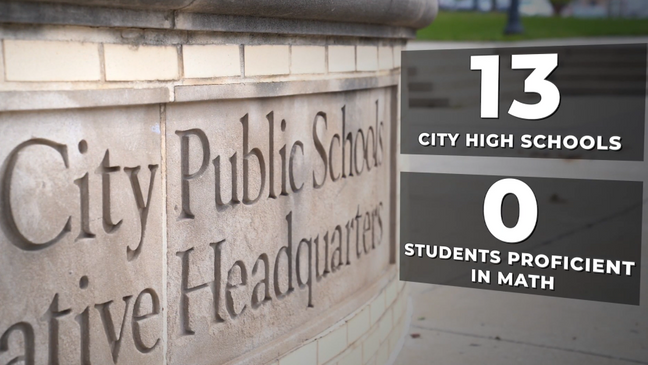
Last month, Project Baltimore reported on 13 high schools in Baltimore City where zero students, among those who took the state test, scored proficient in math (WBFF)
At more than 200 Maryland public schools, 5 percent or fewer students scored proficient in Math
Originally published on FOX45 News
BALTIMORE (WBFF) — How much do parents really know about Maryland public schools? Project Baltimore has learned the latest round of state test scores does not tell the whole story about student outcomes.
Right now, if you go to the Maryland State Department of Education’s website, you can find the 2023 state test scores for every school in Maryland. The data was posted last week.
The website is where parents and taxpayers can go to see how public schools are performing. But if you take a closer look at the test scores, there’s a lot you can’t see. For instance, if you’re looking for information on the lowest-performing schools in Maryland, you won’t find it.
“It's hiding the truth from parents,” said Del. Kathy Szeliga, a Republican representing Baltimore County, who spoke to Project Baltimore in April about an investigation that sparked outrage.
The investigation exposed how the Maryland State Department of Education changed the way it reports student test scores. In the process, much of the data for the lowest-performing schools was hidden behind asterisks.
As a result, parents and taxpayers don’t know how many schools are doing. But Project Baltimore does.
Last month, Project Baltimore reported on 13 high schools in Baltimore City where zero students, among those who took the state test, scored proficient in math. That story shed light on a major problem.
But the only reason Project Baltimore could tell that story is because a source gave us the raw data before it was redacted by the state.
In the version Project Baltimore obtained from the source, the data shows how many students at those 13 high schools took the state math test and how many scored in each level. Under levels three and four, it’s all zeros, which means not a single student scored proficient.
But the data for those schools released by the state looks much different. The results are gone. In levels one and two, the results are replaced with asterisks. And in levels three and four, all the zeros are shown as less than or equal to 5 percent.
Looking at the state’s data, you would have no idea how big the problem really is at those 13 Baltimore City high schools.
And this is potentially the case for hundreds of Maryland schools. There are at least 200 schools where, according to the state’s data, the percentage of students proficient in math is five percent or less. More than 77,000 Maryland students took the test in those roughly 200 schools. There’s a chance none are proficient in math. Project Baltimore only has the raw data for Baltimore City schools. So, taxpayers will never know because the state won’t tell you.
“The State Education Department is instituting a cover-up of what's going on in public schools; it’s outrageous,” Sean Kennedy from the Maryland Public Policy Institute told Project Baltimore in April.
For more than 10 years, MSDE redacted test scores one way. But earlier this year, the state enacted what it called “enhanced deidentification,” which expanded the redactions by replacing much of the test score data with asterisks. The state says this was done to protect student privacy.
Parents and taxpayers like Desmond Stinnie, a Baltimore City father of three, aren’t buying that argument. Stinnie believes if the test scores were better, the state wouldn’t be hiding them.
“I think it's absolutely absurd to use the children and privacy,” said Stinnie. “I would imagine if it were reversed and 89 percent of folks were exceeding the expectations, we would probably have a lot more transparency and insight as to what's really happening.”
In April, when Project Baltimore tried to speak with State Superintendent Mohammed Choudhury about “enhanced deidentification,” he locked himself behind a door.
A month later, in May, Choudhury agreed to speak. He told Project Baltimore that Maryland was federally required to further redact the scores.
“Was MSDE in violation of federal law prior to March with the way the data was being reported?” Project Baltimore’s Chris Papst asked Choudhury.
“No, MSDE was not in violation of federal law,” replied Choudhury.
“Then why was the data changed?” Project Baltimore followed up.
The U.S. Department of Education’s website clearly states under “protecting student privacy” that “These decisions are left up to the individual State.” In other words, the state is choosing to make less information available.
“The public absolutely should see this data as long as we're paying for the school system,” Stinnie told Project Baltimore.
State Superintendent Mohammed Choudhury is expected to resign on October 6 and transition into a new role as senior advisor to the state school board. An interim superintendent will be named later this month. Project Baltimore has asked the State Board of Education if it plans to reverse Choudhury’s decision and make more information available to the public about how schools are performing. We will keep you updated.





